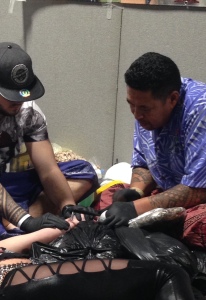At the weekend, I attended the annual ‘Tattoo Tea Party’ convention at Manchester Event City, where hundreds of tattoo artists from across the country convene to showcase their work and advertise their trade. Amongst the many artist practicing using electric needles, there were several using traditional ‘dotwork’ techniques. This method involves a needle which is dipped in ink, mounted on to a wooden shaft with a long handle. The handle is struck lightly which pricks the skin and leaves a dot, which are built up into an image on the bearer’s skin.
This traditional method takes much longer to master than using an electric needle, and is still practiced widely in areas such as Thailand, Samoa and parts of South America, as well as seeing a resurgence of popularity in the UK. Watching the tattoo taking shape using this ancient technique, I thought about the tattoos found on Otzi, the 5,300-year-old ice mummy found in 1992. He bore around sixty tattoos on his body, many of which are still plainly visible today. As Maria Pabst et. al. (2009) explain, Otzi’s tattoos were made with soot from the remains of a fire, possible using a mounted thorn or something similar. They were most likely applied by a third party, but the reasons for these tattoos remain uncertain. Possibly a rite of passage or part of a ritual – and interestingly most are covered by his clothing suggested their primary purpose was not overt display.
I couldn’t resist adding to my collection of tattoos myself while there, although I opted for the electric needle! For me, my tattoos form a kind of personal biography and I feel inquisitive about the reasons why other people have theirs. I find prehistoric examples particularly fascinating as we will never truly know the reasons why the markings have been applied or even what they represent, but we can speculate! I like to think that Otzi’s tattoos were a link to his kin which stayed with him while he travelled, and ultimately perished, into the Italian Alps.
Pabst, Maria Anna, et al. 2009. The tattoos of the Tyrolean Iceman: a light microscopical, ultrastructural and element analytical study. Journal of Archaeological Science 36 (10): 2335-2341.

Some of Otzi’s tattoos are thought to have a medicinal meaning. They correspond with accupunture dots. Cool article ;).
LikeLiked by 1 person